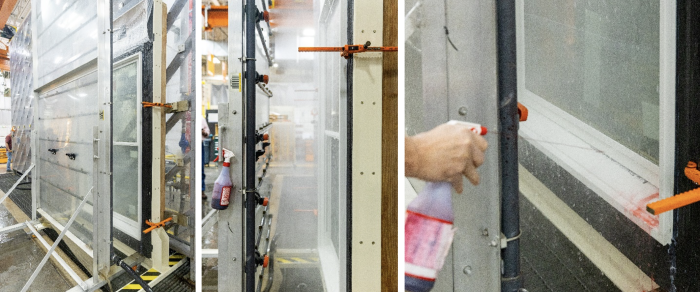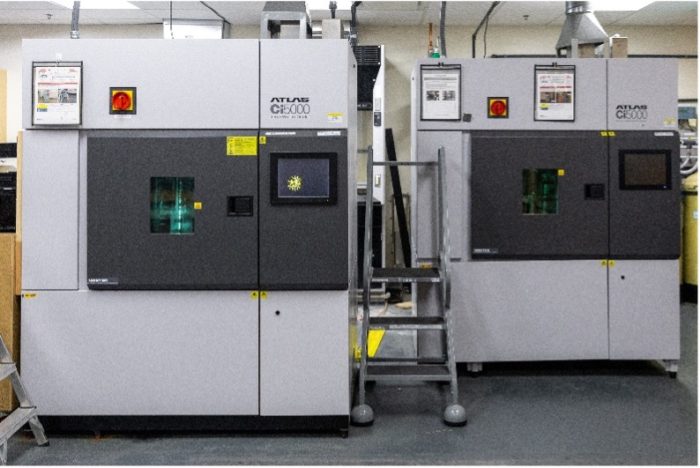
As builders, we are interested in how a window or door performs, its durability and potential longevity, how easily it is installed, and of course, the cost. But have you ever given thought to how manufacturers test their products? I recently had the opportunity to tour Garofalo Center for Research, Development, and Innovation in Bayport, MN. This is where Andersen Windows & Doors “tests to failure,” meaning they test to see at what point their products fail—rather than testing to pass standard requirements.

My tour guide through the facility was Graham Duthie, a mechanical engineer by trade and Technical Leader of Andersen’s Product Life Prediction Team. Entering the testing area, we passed Andersen’s wall of patents exhibiting 265 designs dating back to the early 1900s.
Demonstrated tests
I was shown a series of tests during my visit. The first was ASTM-E547 or “Standard Test Method Exterior Windows, Skylights, Doors, and Curtain Walls by Cyclic Static Air Pressure Differences,” which is a fancy way to describe spraying water on a window or door while subjecting the unit to varying pressure differences to see if it leaks.

This test consists of securing a window or door on a test rig sealed on the interior side and subjecting the window or door to the equivalent of 8 in. of rainfall per hour while applying a pressure difference between inside and outside the window or door; it is the equivalent of a 55 MPH wind gust or about 360 Pascals of pressure. The unit is then observed for water intrusion. If there is a leak, the source can be confirmed using a dye.
The ASTM E331 test applies a constant pressure differential to simulate a steady wind, whereas the E547 test varies the pressure to simulate wind gusts. ASTM E330 tests the structural integrity of the window or door to see how it resists a simulated high-wind event. The video below shows the amount of deflection the test can create in a sliding patio door.
A similar test standard is ASTM E1233, which uses the same testing parameters, but includes cyclic or varying pressure differentials to simulate wind gusts instead of constant wind pressures.
The most impressive test I observed was the ASTM E1886, which entails shooting a 2×4 out of a cannon so it impacts the center of the window or door glass. A second “missile” is shot at the corner of the window or door glass. Once the window is damaged, the unit is taken to the pressure-testing rig and subjected to varying positive and negative pressures, simulating gusty winds and pressure differentials that can occur during a storm. The unit being tested must survive 9,000 pressure cycles; this means the glass, though broken, remains in the frame. According to Graham, this is the toughest residential ASTM window and door test for a product to pass.
Additionally, the performance of window and door hardware is tested using motors and other mechanical equipment to confirm durability of hinges, locking systems, slides, and other operating components.
Andersen’s windows and doors need to function at 120°F to –40°F. They also need to handle the damaging effects of UV radiation. The Garofalo facility has the ability to create temperature differences across a window or door to test the effects of hot summers and cold winters; machines can also simulate the long-term effects of sunlight. This test can introduce humidity into the mix, too—simulating what might be expected in hot-humid climates.

I was surprised to learn that Andersen even tests the effects of transportation and handling on their units; there are ASTM testing standards for packaging and shipping containers (see video below). For instance, ASTM D999 determines what happens to a product if it rides around unsecured in the back of a truck or trailer.
What I learned
My career in the construction industry has been primarily in the residential sector, building in a stable geological location with little risk of tornados and only the occasional high-wind event. This means my clients don’t need windows that can withstand hurricane-force winds and flying debris. Because of this, I was not aware of the performance grade (PG) ratings for windows and doors.
The PG certification rating system has been standardized across the window and door industry. It considers structural loads, water leakage, and air infiltration among other factors. For a window or door to achieve a PG rating, the unit needs to pass several tests including, when applicable:
- Operating force
- Air leakage
- Water penetration resistance
- Uniform load deflection
- Uniform load structural resistance
- Force-entry resistance
The PG rating assigned to a window or door corresponds with the structural load or design pressure the unit is engineered to handle. For example, a PG rating of 20 will show a window or door can handle 20 PSF of structural loading. The scale goes up to PG 100, which is the rating given when a product can handle wind loads of 200 mph. Higher PG ratings often result in a more costly product, but not always.
I asked Graham why Andersen performs so many tests. I would think they would have tested all their window and door lines and would need to test only new products in development. Graham explained that Andersen will re-test a product if there is a change in a supply vendor or material type. Although, long before producing a product, Andersen models changes in materials and designs using software; physical testing confirms whether the unit still performs as expected.
The research and testing that Andersen conducts to advance window and door technology is indicative of the critical role these components have in our buildings. We need them to stand up to time and its elements.
________________________________________________________________________
Randy Williams is a builder and energy auditor in Grand Rapids, Minn. Photos courtesy of manufacturer.
Weekly Newsletter
Get building science and energy efficiency advice, plus special offers, in your inbox.















2 Comments
Great recap of your tour of the Garofalo Center.
It is a very interesting place to visit.
The T-shirt from Elisdyes feature vibrant colors and unique designs that stand out.
Log in or create an account to post a comment.
Sign up Log in